Nanostructured Metals with an Excellent Synergy of Strength and Ductility: A Review
Abstract
:1. Introduction
2. The Bimodal Nanostructure
2.1. Original Intention
2.2. Preparation Methods
2.2.1. Thermomechanical Processing Route
2.2.2. Powder Metallurgy
2.2.3. Electrodeposition Technique
2.3. Strengthening and Toughening Mechanisms
2.4. Summary and Prospect
- (1)
- The “reproducibility” of such structures is not ideal by using the existing preparation methods. The most commonly used methods, such as the thermomechanical processing route and the powder metallurgy, make it difficult to accurately control the grain size, grain morphology, and spatial distribution of the two constituents, due to the inhomogeneity of plastic deformation during plastic processing or ball milling and the temperature nonuniformity during annealing or consolidation [52,58]. These make bimodal nanostructures not so “reproducible” that overall deformation process can be accurately predicted and modeled.
- (2)
- The influences and corresponding mechanisms of microstructure parameters on the mechanical properties are not completely understood. Although previous studies have analyzed the effect of volume fraction of the coarse-grained regions on ductility of Al–7.5Mg alloy, Fe, and 5083 Al [38,39,40], those of the other microstructure parameters, such as the grain sizes, mechanical behaviors, spatial distributions, and more detailed volume–fraction ratio of the two constituents, and the optimum parameters have not been comprehensively clarified. The main reason is that the ideal microstructure cannot be achieved due to the limitations of the processing techniques mentioned above.
- (3)
- The trade-off between strength and ductility still exists sometimes. As for the bimodal structured austenitic steel [20] and Al–Mg alloy [38] prepared using thermomechanical processing and powder metallurgy method, respectively, they showed an increase in strength but a decrease in ductility compared to the corresponding coarse-grained counterparts, which are different from the currently recognized strengthening and toughening mechanisms and need to be further clarified.
3. The Nanotwinned Structure
3.1. Design Concept
3.2. The Single-Order NT Structure
3.2.1. Preparation of Nanotwins
- (1)
- DPD method
- (2)
- PVD method
- (3)
- Electrodeposition method
3.2.2. Strengthening and Toughening Mechanisms
- (1)
- Effect of twin orientation on deformation mechanisms
- (2)
- Effect of λ on strengthening and toughening mechanisms
3.3. HNT Structure
3.3.1. The Preparation of the HNT Structure
3.3.2. Strengthening and Toughening Mechanisms
3.4. Summary and Prospect
4. Gradient Nanostructure
4.1. Gradient Plastic Deformation
- (1)
- GNG structure
- (2)
- GNT structure
4.2. Physical/Chemical Deposition Method
- (1)
- GNG structure
- (2)
- GNT structure
4.3. Strengthening and Toughening Mechanisms
4.3.1. Plastic Strain Gradient
4.3.2. Geometrically Necessary Dislocations
4.3.3. The Relationship between GNDs and the Work-Hardening Rate
4.4. Summary and Prospect
- (1)
- Controllable preparation technologies. At present, the preparation of gradient-nanostructured metals is still dominated by gradient plastic deformation, which can only construct a gradient-nanostructured thin layer on a metal surface, and the volume fraction of gradient structure is very limited, generally 20–25% of the whole sample. More importantly, it is also difficult to accurately control the structure constituents, such as the size and distribution of structure constituents, to achieve the desired microstructure. Meanwhile, similar to the DPD method, the obtained structure is not “clean” and contains high-density dislocations. In contrast, the deposition method can achieve gradient structure distribution by varying the process parameters; similar to the PVD method, the obtained samples have a “clean” microstructure and can fabricate metals with gradient structure from the surface to the interior. However, it is also difficult to realize the engineering application. It can be seen that the development of preparation techniques that can produce gradient structure with higher volume fraction and can accurately control the structure constituents is the focus of the next step in the development of gradient nanostructures, and how to obtain samples with low initial dislocation density is also a problem that needs to be solved.
- (2)
- The relationship between structure and mechanical properties. This relationship is mostly qualitative because the structural gradient from nanometer to macroscopic cannot be precisely controlled during the preparation process, and thus the optimization of the gradient nanostructure is also empirical. This relationship essentially includes the quantitative relationship between strain gradient and GNDs, the specific relationship between GNDs and mobile dislocations, the relationship between the density of GNDs and mechanical properties, etc. Therefore, to understand the relationship between structure and mechanical properties, these relationships need to be clarified. Moreover, coupling of different structures to further improve the mechanical properties of nanostructured metals is only achieved in the GNT structure currently. Hence, how to couple different strengthening and toughening structures to produce nanostructured metals with better mechanical properties is also a scientific issue worthy of further discussion. Due to the limitations of controllable preparation technology, the development of reliable and accurate theoretical models and calculation methods to describe and predict the mechanical properties of metals coupled with different gradient microstructures, and to effectively guide experimental investigation by optimizing the design of microstructures, will be another focus of theoretical research on nanostructured metals.
5. Supra-Nano-Dual-Phase Nanostructure
5.1. Design Concept
5.2. Research Progress
5.3. Summary and Prospect
6. Conclusions
- (1)
- Structure design based on strengthening and toughening mechanisms
- (2)
- Preparation techniques based on the desired structure
- (3)
- Research methods for strengthening and toughening mechanisms
Author Contributions
Funding
Institutional Review Board Statement
Informed Consent Statement
Data Availability Statement
Conflicts of Interest
Abbreviations
| NT | Nanotwinned |
| TBs | Twin boundaries |
| SNDP | Supra-nano-dual-phase |
| GBs | Grain boundaries |
| SPD | Severe plastic deformation |
| YS | Yield strength |
| UTS | Ultimate tensile strength |
| SS | Stainless steel |
| TEM | Transmission electron microscopy |
| EBSD | Electron backscatter diffraction |
| IPF | Inverse pole figure |
| DBs | Deformation bands |
| FGs | Fine grains |
| GNDs | Geometrically necessary dislocations |
| HNT | Hierarchical nanotwinned |
| SFE | Stacking fault energy |
| DPD | Dynamic plastic deformation |
| PVD | Physical vapor deposition |
| SF | Stacking fault |
| λ | Twin thickness |
| SAED | Selected area electron diffraction |
| SEM | Scanning electron microscopy |
| SRX | Static recrystallization grains |
| STEM-HAADF | Scanning transmission electron microscope-high angle annular dark field |
| NG | Nanograins |
| DS | Dislocation structures |
| HRTEM | High-resolution TEM |
| MD | Molecular dynamics |
| TWIP | Twinning-induced plasticity |
| SMAT | Surface mechanical attrition treatment |
| λ1 | Primary twin spacings |
| λ2 | Secondary twin spacing |
| GNG | Gradient-nanograined |
| GNT | Gradient-nanotwinned |
| SMGT | Surface mechanical grinding treatment |
| SMRT | Surface mechanical rolling technique |
| IF | Interstitial free |
| SNC | Supra-nanocrystal |
| SMG | Supra-nano metallic glass |
| GGIs | Glass–glass interfaces |
| FFT | Fast Fourier transform |
References
- Lu, K. The Future of Metals. Science 2010, 328, 319–320. [Google Scholar] [CrossRef] [PubMed]
- Kou, H.; Lu, J.; Li, Y. Nanostructures: High-Strength and High-Ductility Nanostructured and Amorphous Metallic Materials (Adv. Mater. 31/2014). Adv. Mater. 2014, 26, 5517. [Google Scholar] [CrossRef]
- Birringer, R.; Gleiter, H.; Klein, H.P.; Marquardt, P. Nanocrystalline materials an approach to a novel solid structure with gas-like disorder? Phys. Lett. A 1984, 102, 365–369. [Google Scholar] [CrossRef]
- Gleiter, H. Nanocrystalline materials. Prog. Mater. Sci. 1989, 33, 223–315. [Google Scholar] [CrossRef]
- Sriram, S.R.; Parne, S.R.; Pothukanuri, N.; Edla, D.R. Prospects of spray pyrolysis technique for gas sensor applications—A comprehensive review. J. Anal. Appl. Pyrolysis 2022, 164, 105527. [Google Scholar] [CrossRef]
- Lu, L.; Pan, Q.; Hattar, K.; Boyce, B.L. Fatigue and fracture of nanostructured metals and alloys. MRS Bull. 2021, 46, 258–264. [Google Scholar] [CrossRef]
- Zhu, Y.T.; Liao, X. Retaining ductility. Nat. Mater. 2004, 3, 351–352. [Google Scholar] [CrossRef]
- Zhang, X.; Lilleodden, E.; Wang, J. Recent trends on studies of nanostructured metals. MRS Bull. 2021, 46, 217–224. [Google Scholar] [CrossRef]
- Ma, E.; Zhu, T. Towards strength–ductility synergy through the design of heterogeneous nanostructures in metals. Mater. Today 2017, 20, 323–331. [Google Scholar] [CrossRef]
- Guo, X.; Liu, Y.; Weng, G.J.; Zhu, L.; Lu, J.; Chen, G. Microstructure-Property Relations in the Tensile Behavior of Bimodal Nanostructured Metals. Adv. Eng. Mater. 2020, 22, 2000097. [Google Scholar] [CrossRef]
- Li, Z.; Wang, H.; Guo, Q.; Li, Z.; Xiong, D.-B.; Su, Y.; Gao, H.; Li, X.; Zhang, D. Regain Strain-Hardening in High-Strength Metals by Nanofiller Incorporation at Grain Boundaries. Nano Lett. 2018, 18, 6255–6264. [Google Scholar] [CrossRef] [PubMed]
- Ma, K.; Zheng, Y.; Dasari, S.; Zhang, D.; Fraser, H.L.; Banerjee, R. Precipitation in nanostructured alloys: A brief review. MRS Bull. 2021, 46, 250–257. [Google Scholar] [CrossRef]
- Zhang, Z.; Ódor, É.; Farkas, D.; Jóni, B.; Ribárik, G.; Tichy, G.; Nandam, S.-H.; Ivanisenko, J.; Preuss, M.; Ungár, T. Dislocations in Grain Boundary Regions: The Origin of Heterogeneous Microstrains in Nanocrystalline Materials. Metall. Mater. Trans. A 2020, 51, 513–530. [Google Scholar] [CrossRef]
- Zhu, Y.T.; Liao, X.Z.; Wu, X.L. Deformation twinning in nanocrystalline materials. Prog. Mater. Sci. 2012, 57, 1–62. [Google Scholar] [CrossRef]
- Jia, D.; Wang, Y.M.; Ramesh, K.T.; Ma, E.; Zhu, Y.T.; Valiev, R.Z. Deformation behavior and plastic instabilities of ultrafine-grained titanium. Appl. Phys. Lett. 2001, 79, 611–613. [Google Scholar] [CrossRef]
- Kong, H.J.; Yang, T.; Chen, R.; Yue, S.Q.; Zhang, T.L.; Cao, B.X.; Wang, C.; Liu, W.H.; Luan, J.H.; Jiao, Z.B.; et al. Breaking the strength-ductility paradox in advanced nanostructured Fe-based alloys through combined Cu and Mn additions. Scr. Mater. 2020, 186, 213–218. [Google Scholar] [CrossRef]
- Guo, X.; Yang, G.; Weng, G.J. The saturation state of strength and ductility of bimodal nanostructured metals. Mater. Lett. 2016, 175, 131–134. [Google Scholar] [CrossRef]
- Wang, Y.; Chen, M.; Zhou, F.; Ma, E. High tensile ductility in a nanostructured metal. Nature 2002, 419, 912–915. [Google Scholar] [CrossRef]
- Li, X.; Xia, W.; Chen, J.; Yan, H.; Li, Z.; Su, B.; Song, M. Bimodal-Structured Al–Mg Alloy with High Strength and Ductility Processed by High Strain Rate Rolling at Medium Temperature. Met. Mater. Int. 2021, 27, 5191–5198. [Google Scholar] [CrossRef]
- Niu, G.; Wu, H.; Zhang, D.; Gong, N.; Tang, D. Heterogeneous nano/ultrafine-grained medium Mn austenitic stainless steel with high strength and ductility. Mater. Sci. Eng. A 2018, 725, 187–195. [Google Scholar] [CrossRef]
- Lu, L.; Lu, K. Metallic materials with nano—Scale twins. Acta Metall. Sin. 2011, 46, 1422–1427. [Google Scholar] [CrossRef]
- Sansoz, F.; Lu, K.; Zhu, T.; Misra, A. Strengthening and plasticity in nanotwinned metals. MRS Bull. 2016, 41, 292–297. [Google Scholar] [CrossRef]
- Wu, K.; Zhu, L. Mechanical properties of nanotwinned metals with bimodal twin spacing distribution. China Sci. 2018, 13, 494–498. [Google Scholar] [CrossRef]
- You, Z.; Lu, L. Deformation and fracture mechanisms of nanotwinned metals. Natl. Sci. Rev. 2017, 4, 519–521. [Google Scholar] [CrossRef]
- Pan, Q.; Lu, L. Improved fatigue resistance of gradient nanograined metallic materials: Suppress strain localization and damage accumulation. Scr. Mater. 2020, 187, 301–306. [Google Scholar] [CrossRef]
- Lu, K. Gradient nanostructured materials. Acta Metall. Sin. 2015, 51, 1–10. [Google Scholar] [CrossRef]
- Li, X.; Lu, L.; Li, J.; Zhang, X.; Gao, H. Mechanical properties and deformation mechanisms of gradient nanostructured metals and alloys. Nat. Rev. Mater. 2020, 5, 706–723. [Google Scholar] [CrossRef]
- Cheng, Z.; Zhou, H.; Lu, Q.; Gao, H.; Lu, L. Extra strengthening and work hardening in gradient nanotwinned metals. Science 2018, 362, eaau1925. [Google Scholar] [CrossRef]
- Wu, G.; Chan, K.; Zhu, L.; Sun, L.; Lu, J. Dual-phase nanostructuring as a route to high-strength magnesium alloys. Nature 2017, 545, 80–83. [Google Scholar] [CrossRef]
- Wu, G.; Liu, C.; Sun, L.; Wang, Q.; Sun, B.; Han, B.; Kai, J.; Luan, J.; Liu, C.T.; Cao, K.; et al. Hierarchical nanostructured aluminum alloy with ultrahigh strength and large plasticity. Nat. Commun. 2019, 10, 5099. [Google Scholar] [CrossRef] [Green Version]
- Ma, E. Instabilities and ductility of nanocrystalline and ultrafine-grained metals. Scr. Mater. 2003, 49, 663–668. [Google Scholar] [CrossRef]
- Wang, Y.; Zhu, G.; Chen, Q.; Ding, H.; Wan, D. A Review on the Plastic Behavior and Improvement of Plasticity in High Strength Ultrafine-grained Metallic Materials. Cailiao Daobao/Mater. Rev. 2018, 32, 3414–3422. [Google Scholar] [CrossRef]
- Cao, G.H.; Peng, Y.F.; Liu, N.; Li, X.; Lei, Z.S.; Ren, Z.M.; Gerthsen, D.; Russell, A.M. Formation of a bimodal structure in ultrafine Ti–Fe–Nb alloys with high-strength and enhanced ductility. Mater. Sci. Eng. A 2014, 609, 60–64. [Google Scholar] [CrossRef]
- Zhang, Y.; Wang, C.; Reddy, K.M.; Li, W.; Wang, X. Study on the deformation mechanism of a high-nitrogen duplex stainless steel with excellent mechanical properties originated from bimodal grain design. Acta Mater. 2022, 226, 117670. [Google Scholar] [CrossRef]
- Sun, J.; Yang, C.; Guo, S.; Sun, X.; Ma, M.; Zhao, S.; Liu, Y. A novel process to obtain lamella structured low-carbon steel with bimodal grain size distribution for potentially improving mechanical property. Mater. Sci. Eng. A 2020, 785, 139339. [Google Scholar] [CrossRef]
- Okitsu, Y.; Takata, N.; Tsuji, N. Mechanical properties of ultrafine grained ferritic steel sheets fabricated by rolling and annealing of duplex microstructure. J. Mater. Sci. 2008, 43, 7391–7396. [Google Scholar] [CrossRef]
- Wang, T.S.; Li, Z.; Zhang, B.; Zhang, X.J.; Deng, J.M.; Zhang, F.C. High tensile ductility and high strength in ultrafine-grained low-carbon steel. Mater. Sci. Eng. A 2010, 527, 2798–2801. [Google Scholar] [CrossRef]
- Witkin, D.; Lee, Z.; Rodriguez, R.; Nutt, S.; Lavernia, E. Al–Mg alloy engineered with bimodal grain size for high strength and increased ductility. Scr. Mater. 2003, 49, 297–302. [Google Scholar] [CrossRef]
- Srinivasarao, B.; Ohishi, K.; Ohkubo, T.; Hono, K. Bimodally grained high-strength Fe fabricated by mechanical alloying and spark plasma sintering. Acta Mater. 2009, 57, 3277–3286. [Google Scholar] [CrossRef]
- Han, B.O.; Lavernia, E.J.; Lee, Z.; Nutt, S.; Witkin, D. Deformation behavior of bimodal nanostructured 5083 Al alloys. Metall. Mater. Trans. A 2005, 36, 957–965. [Google Scholar] [CrossRef]
- Shakoorioskooie, M.; Asgharzadeh, H. Strength and ductility enhancement in nanostructured AI6063 with a bimodal grain size distribution. IOP Conf. Ser. Mater. Sci. Eng. 2014, 63, 012022. [Google Scholar] [CrossRef]
- Zhang, Q.; Liu, Y.; Liu, Y.; Ren, Y.; Wu, Y.; Gao, Z.; Wu, X.; Han, P. Enhanced tensile ductility and strength of electrodeposited ultrafine-grained nickel with a desired bimodal microstructure. Mater. Sci. Eng. A 2017, 701, 196–202. [Google Scholar] [CrossRef]
- Wu, X.; Yuan, F.; Yang, M.; Jiang, P.; Zhang, C.; Chen, L.; Wei, Y.; Ma, E. Nanodomained Nickel Unite Nanocrystal Strength with Coarse-Grain Ductility. Sci. Rep. 2015, 5, 11728. [Google Scholar] [CrossRef] [PubMed]
- Gu, C.; Lian, J.; Jiang, Z.; Jiang, Q. Enhanced tensile ductility in an electrodeposited nanocrystalline Ni. Scr. Mater. 2006, 54, 579–584. [Google Scholar] [CrossRef]
- Tao, N.; Lu, K. Preparation techniques for nanostructured metallic materials via plastic deformation. Acta Metall. Sin. 2014, 50, 141–147. [Google Scholar] [CrossRef]
- Wang, H.D.; La, P.; Shi, T.; Wei, Y.P.; Lu, X. Research status and development trend of bulk nano/micro-crystalline composite metallic materials. J. Mater. Eng. 2013, 3, 92–96. [Google Scholar] [CrossRef]
- Cheng, Z.; Lu, L. The effect of gradient order on mechanical behaviors of gradient nanotwinned Cu. Scr. Mater. 2019, 164, 130–134. [Google Scholar] [CrossRef]
- Shen, X.; Lian, J.; Jiang, Z.; Jiang, Q. High strength and high ductility of electrodeposited nanocrystalline Ni with a broad grain size distribution. Mater. Sci. Eng. A 2008, 487, 410–416. [Google Scholar] [CrossRef]
- Zhu, L. Strength and Toughness Properties in Nanotwinned Metals and Gradient-nanostructured Metals: A Review. Acta Mech. Solida Sin. 2019, 40, 1–20. [Google Scholar] [CrossRef]
- Shekhar, S.; Cai, J.; Wang, J.; Shankar, M.R. Multimodal ultrafine grain size distributions from severe plastic deformation at high strain rates. Mater. Sci. Eng. A 2009, 527, 187–191. [Google Scholar] [CrossRef]
- Wu, X.; Zhu, Y. Heterogeneous materials: A new class of materials with unprecedented mechanical properties. Mater. Res. Lett. 2017, 5, 527–532. [Google Scholar] [CrossRef]
- Li, J.; Lu, W.; Chen, S.; Liu, C. Revealing extra strengthening and strain hardening in heterogeneous two-phase nanostructures. Int. J. Plast. 2020, 126, 102626. [Google Scholar] [CrossRef]
- Sigl, L.S.; Mataga, P.A.; Dalgleish, B.J.; McMeeking, R.M.; Evans, A.G. On the toughness of brittle materials reinforced with a ductile phase. Acta Metall. 1988, 36, 945–953. [Google Scholar] [CrossRef]
- Zhu, L.; Lu, J. Modelling the plastic deformation of nanostructured metals with bimodal grain size distribution. Int. J. Plast. 2012, 30–31, 166–184. [Google Scholar] [CrossRef]
- Liu, Y.; Ju, R.; Li, H.; Zhao, G. Constitutive behavior of bimodal nanocrystalline materials. Chin. J. Mater. Res. 2015, 29, 889–894. [Google Scholar] [CrossRef]
- Ramtani, S.; Dirras, G.; Bui, H.Q. A bimodal bulk ultra-fine-grained nickel: Experimental and micromechanical investigations. Mech. Mater. 2010, 42, 522–536. [Google Scholar] [CrossRef]
- Zhao, Y.; Topping, T.; Bingert, J.; Thornton, J.; Jokisaari, A.; Li, Y.; Liu, W.; Zhu, Y.; Zhou, Y.; Lavernia, E. High Tensile Ductility and Strength in Bulk Nanostructured Nickel. Adv. Mater. 2008, 20, 3028–3033. [Google Scholar] [CrossRef]
- Xia, S.H.; Vychigzhanina, L.V.; Wang, J.T.; Alexandrov, I.V.; Sharafutdinov, A.V. Controllable bimodal structures in hypo-eutectoid Cu–Al alloy for both high strength and tensile ductility. Mater. Sci. Eng. A 2008, 490, 471–476. [Google Scholar] [CrossRef]
- Lu, L.; Shen, Y.; Chen, X.; Qian, L.; Lu, K. Ultrahigh strength and high electrical conductivity in copper. Science 2004, 304, 422–426. [Google Scholar] [CrossRef] [PubMed]
- Lu, L.; Chen, X.; Huang, X.; Lu, K. Revealing the maximum strength in nanotwinned copper. Science 2009, 323, 607–610. [Google Scholar] [CrossRef] [PubMed]
- Lu, K.; Lu, L.; Suresh, S. Strengthening materials by engineering coherent internal boundaries at the nanoscale. Science 2009, 324, 349–352. [Google Scholar] [CrossRef] [PubMed]
- Lu, N.; Du, K.; Lu, L.; Ye, H.Q. Transition of dislocation nucleation induced by local stress concentration in nanotwinned copper. Nat. Commun. 2015, 6, 7648. [Google Scholar] [CrossRef] [PubMed]
- Zhao, S.; Zhang, R.; Yu, Q.; Ell, J.; Ritchie Robert, O.; Minor Andrew, M. Cryoforged nanotwinned titanium with ultrahigh strength and ductility. Science 2021, 373, 1363–1368. [Google Scholar] [CrossRef] [PubMed]
- Dao, M.; Lu, L.; Shen, Y.F.; Suresh, S. Strength, strain-rate sensitivity and ductility of copper with nanoscale twins. Acta Mater. 2006, 54, 5421–5432. [Google Scholar] [CrossRef]
- Zhang, B.B.; Tao, N.R.; Lu, K. A high strength and high electrical conductivity bulk Cu-Ag alloy strengthened with nanotwins. Scr. Mater. 2017, 129, 39–43. [Google Scholar] [CrossRef]
- Guo, J.; Lu, Q.; Lu, L. Effect of twins on the storage capacity of dislocations in submicron-crystalline pure copper. Acta Metall. Sin. 2006, 42, 903–908. [Google Scholar] [CrossRef]
- Sun, L.; He, X.; Lu, J. Nanotwinned and hierarchical nanotwinned metals: A review of experimental, computational and theoretical efforts. Npj Comput. Mater. 2018, 4, 6. [Google Scholar] [CrossRef]
- Sun, L.G.; Wu, G.; Wang, Q.; Lu, J. Nanostructural metallic materials: Structures and mechanical properties. Mater. Today 2020, 38, 114–135. [Google Scholar] [CrossRef]
- Zhu, L.; Kou, H.; Lu, J. On the role of hierarchical twins for achieving maximum yield strength in nanotwinned metals. Appl. Phys. Lett. 2012, 101, 081906. [Google Scholar] [CrossRef]
- Zhang, X.; Wang, H.; Chen, X.H.; Lu, L.; Lu, K.; Hoagland, R.G.; Misra, A. High-strength sputter-deposited Cu foils with preferred orientation of nanoscale growth twins. Appl. Phys. Lett. 2006, 88, 173116. [Google Scholar] [CrossRef] [Green Version]
- Bufford, D.; Wang, H.; Zhang, X. High strength, epitaxial nanotwinned Ag films. Acta Mater. 2011, 59, 93–101. [Google Scholar] [CrossRef]
- Valentino, G.M.; Xiang, S.; Ma, L.; Xie, K.Y.; He, M.; Oliver, W.C.; Pharr, G.M.; Krogstad, J.A.; Weihs, T.P.; Hemker, K.J. Investigating the compressive strength and strain localization of nanotwinned nickel alloys. Acta Mater. 2021, 204, 116507. [Google Scholar] [CrossRef]
- Xiong, L.; You, Z.S.; Qu, S.D.; Lu, L. Fracture behavior of heterogeneous nanostructured 316L austenitic stainless steel with nanotwin bundles. Acta Mater. 2018, 150, 130–138. [Google Scholar] [CrossRef]
- Yan, F.K.; Liu, G.Z.; Tao, N.R.; Lu, K. Strength and ductility of 316L austenitic stainless steel strengthened by nano-scale twin bundles. Acta Mater. 2012, 60, 1059–1071. [Google Scholar] [CrossRef]
- You, Z.; Luo, S.; Lu, L. Size effect of deformation nanotwin bundles on their strengthening and toughening in heterogeneous nanostructured Cu. Sci. China Technol. Sci. 2021, 64, 23–31. [Google Scholar] [CrossRef]
- Li, Y.S.; Tao, N.R.; Lu, K. Microstructural evolution and nanostructure formation in copper during dynamic plastic deformation at cryogenic temperatures. Acta Mater. 2008, 56, 230–241. [Google Scholar] [CrossRef]
- Zhang, Y.; Tao, N.R.; Lu, K. Mechanical properties and rolling behaviors of nano-grained copper with embedded nano-twin bundles. Acta Mater. 2008, 56, 2429–2440. [Google Scholar] [CrossRef]
- Zhang, X.; Anderoglu, O.; Hoagland, R.G.; Misra, A. Nanoscale growth twins in sputtered metal films. JOM 2008, 60, 75–78. [Google Scholar] [CrossRef]
- Ott, R.T.; Geng, J.; Besser, M.F.; Kramer, M.J.; Wang, Y.M.; Park, E.S.; LeSar, R.; King, A.H. Optimization of strength and ductility in nanotwinned ultra-fine grained Ag: Twin density and grain orientations. Acta Mater. 2015, 96, 378–389. [Google Scholar] [CrossRef]
- Li, S.; Zhu, Q.; Zheng, B.; Yuan, J.; Wang, X. Nano-scale twinned Cu with ultrahigh strength prepared by direct current electrodeposition. Mater. Sci. Eng. A 2019, 758, 1–6. [Google Scholar] [CrossRef]
- Zhan, X.; Lian, J.; Li, H.; Wang, X.; Zhou, J.; Trieu, K.; Zhang, X. Preparation of highly (111) textured nanotwinned copper by medium-frequency pulsed electrodeposition in an additive-free electrolyte. Electrochim. Acta 2021, 365, 137391. [Google Scholar] [CrossRef]
- Yang, X.; Wang, Y.; Zhai, H.; Wang, G.; Su, Y.; Dai, L.; Ogata, S.; Zhang, T. Time-, stress-, and temperature-dependent deformation in nanostructured copper: Creep tests and simulations. J. Mech. Phys. Solids 2016, 94, 191–206. [Google Scholar] [CrossRef]
- Han, J.; Zhang, Y.; Ma, Y.; Liu, L.; Yang, Z.; Zhang, Z. Research progress in the strengthening mechanisms and preparation techniques of nanotwin-strengthened alloys. Mater. Rep. 2022, 36, 21050108. [Google Scholar] [CrossRef]
- Zhang, Y.Z.; Wang, J.J.; Tao, N.R. Tensile ductility and deformation mechanisms of a nanotwinned 316L austenitic stainless steel. J. Mater. Sci. Technol. 2020, 36, 65–69. [Google Scholar] [CrossRef]
- Van Swygenhoven, H.; Derlet, P.M. Atomistic simulations of dislocations in fcc metallic nanocrystalline materials. In Dislocations in Solids; Elsevier: Amsterdam, The Netherlands, 2008; pp. 1–42. [Google Scholar]
- Li, Q.; Yan, F.K.; Tao, N.R. Enhanced fatigue damage resistance of nanotwinned austenitic grains in a nanotwinned stainless steel. Scr. Mater. 2017, 136, 59–63. [Google Scholar] [CrossRef]
- Meyers, M.A.; Vöhringer, O.; Lubarda, V.A. The onset of twinning in metals: A constitutive description. Acta Mater. 2001, 49, 4025–4039. [Google Scholar] [CrossRef]
- Yin, Z.; Sun, L.; Yang, J.; Gong, Y.; Zhu, X. Mechanical behavior and deformation kinetics of gradient structured Cu-Al alloys with varying stacking fault energy. J. Alloy. Compd. 2016, 687, 152–160. [Google Scholar] [CrossRef]
- Christian, J.W.; Mahajan, S. Deformation twinning. Prog. Mater. Sci. 1995, 39, 1–157. [Google Scholar] [CrossRef]
- Zener, C.; Hollomon, J. Effect of strain rate upon plastic flow of steel. J. Appl. Phys. 1944, 15, 22–32. [Google Scholar] [CrossRef]
- Li, Y.S.; Zhang, Y.; Tao, N.R.; Lu, K. Effect of the zener–hollomon parameter on the microstructures and mechanical properties of Cu subjected to plastic deformation. Acta Mater. 2009, 57, 761–772. [Google Scholar] [CrossRef]
- Tao, N.; Lu, K. Dynamic plastic deformation (DPD): A novel technique for synthesizing bulk nanostructured metals. J. Mater. Sci. Technol. 2007, 23, 771–774. [Google Scholar] [CrossRef]
- Lu, K.; Yan, F.K.; Wang, H.T.; Tao, N.R. Strengthening austenitic steels by using nanotwinned austenitic grains. Scr. Mater. 2012, 66, 878–883. [Google Scholar] [CrossRef]
- Lu, K. Stabilizing nanostructures in metals using grain and twin boundary architectures. Nat. Rev. Mater. 2016, 1, 16019. [Google Scholar] [CrossRef]
- Xiong, L.; You, Z.; Lu, L. Enhancing fracture toughness of nanotwinned austenitic steel by thermal annealing. Scr. Mater. 2016, 119, 55–59. [Google Scholar] [CrossRef]
- Vassamillet, L.; Massalski, T. Stacking fault probabilities of some alloys of copper and silver with zinc and cadmium. J. Appl. Phys. 1963, 34, 3398–3402. [Google Scholar] [CrossRef]
- Zhang, Y.; Tao, N.R.; Lu, K. Effect of stacking-fault energy on deformation twin thickness in Cu–Al alloys. Scr. Mater. 2009, 60, 211–213. [Google Scholar] [CrossRef]
- Zhang, Y.; Li, Y.; Tao, N.; Lu, K. High strength and high electrical conductivity in bulk nanograined Cu embedded with nanoscale twins. Appl. Phys. Lett. 2007, 91, 211901. [Google Scholar] [CrossRef]
- Kumar, K.S.; Van Swygenhoven, H.; Suresh, S. Mechanical behavior of nanocrystalline metals and alloys. Acta Mater. 2003, 51, 5743–5774. [Google Scholar] [CrossRef]
- Bufford, D.C.; Wang, Y.M.; Liu, Y.; Lu, L. Synthesis and microstructure of electrodeposited and sputtered nanotwinned face-centered-cubic metals. MRS Bull. 2016, 41, 286–291. [Google Scholar] [CrossRef]
- Zhang, X.; Misra, A.; Wang, H.; Shen, T.D.; Nastasi, M.; Mitchell, T.E.; Hirth, J.P.; Hoagland, R.G.; Embury, J.D. Enhanced hardening in Cu/330 stainless steel multilayers by nanoscale twinning. Acta Mater. 2004, 52, 995–1002. [Google Scholar] [CrossRef]
- Shen, Y.F.; Lu, L.; Lu, Q.H.; Jin, Z.H.; Lu, K. Tensile properties of copper with nano-scale twins. Scr. Mater. 2005, 52, 989–994. [Google Scholar] [CrossRef]
- Cheng, Z.; Jin, S.; Lu, L. Effect of electrolyte temperature on microstructures of direct-current electrodeposited nanotwinned Cu. Acta Metall. Sin. 2018, 54, 428–434. [Google Scholar] [CrossRef]
- Zhang, P.; Zhang, J.Y.; Li, J.; Liu, G.; Wu, K.; Wang, Y.Q.; Sun, J. Combined effect of texture and nanotwins on mechanical properties of the nanostructured Cu and Cu–Al films prepared by magnetron sputtering. J. Mater. Sci. 2015, 50, 1901–1907. [Google Scholar] [CrossRef]
- Anderoglu, O.; Misra, A.; Wang, H.; Ronning, F.; Hundley, M.; Zhang, X. Epitaxial nanotwinned Cu films with high strength and high conductivity. Appl. Phys. Lett. 2008, 93, 083108. [Google Scholar] [CrossRef]
- Jin, S.; Pan, Q.; Lu, L. Microstructure dependence of direct-current electrodeposited bulk Cu with preferentially oriented nanotwins on the current densities. Acta Metall. Sin. 2013, 49, 635–640. [Google Scholar] [CrossRef]
- Lu, K. Metallic nanostructured materials. Sci. Focus 2017, 12, 21–22. [Google Scholar] [CrossRef]
- Duan, F.; Lin, Y.; Pan, J.; Zhao, L.; Guo, Q.; Zhang, D.; Li, Y. Ultrastrong nanotwinned pure nickel with extremely fine twin thickness. Sci. Adv. 2021, 7, eabg5113. [Google Scholar] [CrossRef]
- Liu, T.; Liu, C.; Hsiao, H.Y.; Lu, J.; Huang, Y.; Chen, C. Fabrication and characterization of (111)-oriented and nanotwinned Cu by DC electrodeposition. Cryst. Growth Des. 2012, 12, 5012–5016. [Google Scholar] [CrossRef]
- You, Z.; Li, X.; Gui, L.; Lu, Q.; Zhu, T.; Gao, H.; Lu, L. Plastic anisotropy and associated deformation mechanisms in nanotwinned metals. Acta Mater. 2013, 61, 217–227. [Google Scholar] [CrossRef]
- Lu, L.; You, Z. Plastic deformation mechanisms in nanotwinned metals. Acta Metall. Sin. 2014, 50, 129–136. [Google Scholar] [CrossRef]
- Misra, A.; Hirth, J.P.; Hoagland, R.G. Length-scale-dependent deformation mechanisms in incoherent metallic multilayered composites. Acta Mater. 2005, 53, 4817–4824. [Google Scholar] [CrossRef]
- Li, X.; Wei, Y.; Lu, L.; Lu, K.; Gao, H. Dislocation nucleation governed softening and maximum strength in nano-twinned metals. Nature 2010, 464, 877–880. [Google Scholar] [CrossRef] [PubMed]
- Guo, Y.; Sun, T.; Fu, L.; Hao, L.; Huang, M.; Wei, R.; Luo, J.; He, X.; Wang, X.; Xiong, X.; et al. In situ atomic-scale observation of dislocation behaviors in twin-structured Pt nanocrystals. Sci. China Technol. Sci. 2021, 64, 599–604. [Google Scholar] [CrossRef]
- Li, J.C.; Wang, K.G. Theoretical prediction for mechanical properties in nanotwinned and hierarchically nanotwinned metals with different twin orders. Mater. Today Commun. 2020, 23, 100887. [Google Scholar] [CrossRef]
- Cong, D.Y.; Zhang, Y.D.; Esling, C.; Wang, Y.D.; Lecomte, J.S.; Zhao, X.; Zuo, L. Microstructural and crystallographic characteristics of interpenetrating and non-interpenetrating multiply twinned nanostructure in a Ni–Mn–Ga ferromagnetic shape memory alloy. Acta Mater. 2011, 59, 7070–7081. [Google Scholar] [CrossRef]
- Li, Q.; Xue, S.; Price, P.; Sun, X.; Ding, J.; Shang, Z.; Fan, Z.; Wang, H.; Zhang, Y.; Chen, Y.; et al. Hierarchical nanotwins in single-crystal-like nickel with high strength and corrosion resistance produced via a hybrid technique. Nanoscale 2020, 12, 1356–1365. [Google Scholar] [CrossRef]
- Tao, N.R.; Lu, K. Nanoscale structural refinement via deformation twinning in face-centered cubic metals. Scr. Mater. 2009, 60, 1039–1043. [Google Scholar] [CrossRef]
- Qu, S.; An, X.H.; Yang, H.J.; Huang, C.X.; Yang, G.; Zang, Q.S.; Wang, Z.G.; Wu, S.D.; Zhang, Z.F. Microstructural evolution and mechanical properties of Cu–Al alloys subjected to equal channel angular pressing. Acta Mater. 2009, 57, 1586–1601. [Google Scholar] [CrossRef]
- Wei, Y.; Li, Y.; Zhu, L.; Liu, Y.; Lei, X.; Wang, G.; Wu, Y.; Mi, Z.; Liu, J.; Wang, H.; et al. Evading the strength–ductility trade-off dilemma in steel through gradient hierarchical nanotwins. Nat. Commun. 2014, 5, 3580. [Google Scholar] [CrossRef]
- Ren, L.; Xiao, W.; Kent, D.; Wan, M.; Ma, C.; Zhou, L. Simultaneously enhanced strength and ductility in a metastable β-Ti alloy by stress-induced hierarchical twin structure. Scr. Mater. 2020, 184, 6–11. [Google Scholar] [CrossRef]
- An, Z.; Mao, S.; Liu, Y.; Zhou, H.; Zhai, Y.; Tian, Z.; Liu, C.; Zhang, Z.; Han, X. Hierarchical grain size and nanotwin gradient microstructure for improved mechanical properties of a non-equiatomic CoCrFeMnNi high-entropy alloy. J. Mater. Sci. Technol. 2021, 92, 195–207. [Google Scholar] [CrossRef]
- Zhang, Z.; Sheng, H.; Wang, Z.; Gludovatz, B.; Zhang, Z.; George, E.P.; Yu, Q.; Mao, S.X.; Ritchie, R.O. Dislocation mechanisms and 3D twin architectures generate exceptional strength-ductility-toughness combination in CrCoNi medium-entropy alloy. Nat. Commun. 2017, 8, 14390. [Google Scholar] [CrossRef] [PubMed]
- Liu, X.; Sun, L.; Zhu, L.; Liu, J.; Lu, K.; Lu, J. High-order hierarchical nanotwins with superior strength and ductility. Acta Mater. 2018, 149, 397–406. [Google Scholar] [CrossRef]
- Fu, H.; Ge, B.; Xin, Y.; Wu, R.; Fernandez, C.; Huang, J.; Peng, Q. Achieving high strength and ductility in magnesium alloys via densely hierarchical double contraction nanotwins. Nano Lett. 2017, 17, 6117–6124. [Google Scholar] [CrossRef]
- Chung, T.F.; Chen, P.; Tai, C.; Chiu, P.; Lin, Y.; Hsiao, C.; Chen, C.; Wang, S.; Yeh, J.; Lee, W.; et al. Investigation of nanotwins in the bimodal-structured Fe22Co22Ni20Cr22Mn14 alloy subjected to high-strain-rate deformation at cryogenic temperatures. Mater. Charact. 2020, 170, 110667. [Google Scholar] [CrossRef]
- Sun, F.; Zhang, J.Y.; Marteleur, M.; Gloriant, T.; Vermaut, P.; Laillé, D.; Castany, P.; Curfs, C.; Jacques, P.J.; Prima, F. Investigation of early stage deformation mechanisms in a metastable β titanium alloy showing combined twinning-induced plasticity and transformation-induced plasticity effects. Acta Mater. 2013, 61, 6406–6417. [Google Scholar] [CrossRef]
- Gludovatz, B.; Hohenwarter, A.; Thurston, K.V.S.; Bei, H.; Wu, Z.; George, E.P.; Ritchie, R.O. Exceptional damage-tolerance of a medium-entropy alloy CrCoNi at cryogenic temperatures. Nat. Commun. 2016, 7, 10602. [Google Scholar] [CrossRef]
- Zhu, L.; Qu, S.; Guo, X.; Lu, J. Analysis of the twin spacing and grain size effects on mechanical properties in hierarchically nanotwinned face-centered cubic metals based on a mechanism-based plasticity model. J. Mech. Phys. Solids 2015, 76, 162–179. [Google Scholar] [CrossRef]
- Guo, X.; Ji, R.; Weng, G.J.; Zhu, L.L.; Lu, J. Computer simulation of strength and ductility of nanotwin-strengthened coarse-grained metals. Model. Simul. Mater. Sci. Eng. 2014, 22, 075014. [Google Scholar] [CrossRef]
- Sun, L.; Li, D.; Zhu, L.; Ruan, H.; Lu, J. Size-dependent formation and thermal stability of high-order twins in hierarchical nanotwinned metals. Int. J. Plast. 2020, 128, 102685. [Google Scholar] [CrossRef]
- Sun, L.; He, X.; Zhu, L.; Lu, J. Two softening stages in nanotwinned Cu. Philos. Mag. 2014, 94, 4037–4052. [Google Scholar] [CrossRef]
- Yuan, F.; Wu, X. Size effects of primary/secondary twins on the atomistic deformation mechanisms in hierarchically nanotwinned metals. J. Appl. Phys. 2013, 113, 203516. [Google Scholar] [CrossRef]
- Li, J.; Wang, K. Size effect on mechanical properties in high-order hierarchically nanotwinned metals. J. Mater. Res. 2019, 34, 2177–2193. [Google Scholar] [CrossRef]
- Miyamoto, Y.; Kaysser, W.A.; Rabin, B.H.; Kawasaki, A.; Ford, R. Functionally Graded Materials: Design, Processing and Applications; Springer: Berlin/Heidelberg, Germany, 1999; pp. 1–6. [Google Scholar]
- Fang, T.H.; Li, W.L.; Tao, N.R.; Lu, K. Revealing extraordinary intrinsic tensile plasticity in gradient nano-grained copper. Science 2011, 331, 1587–1590. [Google Scholar] [CrossRef] [PubMed]
- Li, Y. Research progress on gradient metallic materials. Mater. China 2016, 35, 658–665. [Google Scholar] [CrossRef]
- Xia, S.; Liu, Y.; Lv, J. The gradient nano structured of Mg alloys. Mater. China 2016, 35, 825–834. [Google Scholar] [CrossRef]
- Zhou, H. Progress in mechanical properties, deformation mechanisms and multiscale simulations of gradient nanostructured metals. Chin. J. Solid Mech. 2019, 40, 193–212. [Google Scholar] [CrossRef]
- Wang, C.; Luo, K.; Wang, J.; Lu, J. Carbide-facilitated nanocrystallization of martensitic laths and carbide deformation in AISI 420 stainless steel during laser shock peening. Int. J. Plast. 2022, 150, 103191. [Google Scholar] [CrossRef]
- Liu, S.; Lei, P.; Liu, M.; Zhang, G.; Chen, C.; Zhou, K. Additive manufactured Ti-6Al-4V alloy with graded microstructure by selective laser melting. Rare Met. Mater. Eng. 2021, 50, 3543–3549. [Google Scholar]
- Cheng, Q.; Wang, Y.; Wei, W.; Guo, F.; He, Q.; Wang, M.; Huang, C. Superior strength-ductility synergy achieved by synergistic strengthening and strain delocalization in a gradient-structured high-manganese steel. Mater. Sci. Eng. A 2021, 825, 141853. [Google Scholar] [CrossRef]
- Chen, A.; Liu, J.; Wang, H.; Lu, J.; Wang, Y.M. Gradient twinned 304 stainless steels for high strength and high ductility. Mater. Sci. Eng. A 2016, 667, 179–188. [Google Scholar] [CrossRef] [Green Version]
- Wu, X.; Jiang, P.; Chen, L.; Yuan, F.; Zhu, Y. Extraordinary strain hardening by gradient structure. Proc. Natl. Acad. Sci. USA 2014, 111, 7197–7201. [Google Scholar] [CrossRef] [PubMed]
- Chen, H.; Yang, J.; Zhou, H.; Moering, J.; Yin, Z.; Gong, Y.; Zhao, K. Mechanical properties of gradient structure Mg alloy. Metall. Mater. Trans. A 2017, 48, 3961–3970. [Google Scholar] [CrossRef]
- Wu, X.; Yang, M.; Li, R.; Jiang, P.; Yuan, F.; Wang, Y.; Zhu, Y.; Wei, Y. Plastic accommodation during tensile deformation of gradient structure. Sci. China Mater. 2021, 64, 1534–1544. [Google Scholar] [CrossRef]
- Sun, W.; Wu, B.; Fu, H.; Yang, X.; Qiao, X.; Zheng, M.; He, Y.; Lu, J.; Shi, S. Combining gradient structure and supersaturated solid solution to achieve superior mechanical properties in WE43 magnesium alloy. J. Mater. Sci. Technol. 2022, 99, 223–238. [Google Scholar] [CrossRef]
- Xu, W.; Liu, X.C.; Li, X.Y.; Lu, K. Deformation induced grain boundary segregation in nanolaminated Al–Cu alloy. Acta Mater. 2020, 182, 207–214. [Google Scholar] [CrossRef]
- Carneiro, L.; Wang, X.; Jiang, Y. Cyclic deformation and fatigue behavior of 316L stainless steel processed by surface mechanical rolling treatment. Int. J. Fatigue 2020, 134, 105469. [Google Scholar] [CrossRef]
- Zhang, K.; Wang, Z.B. Strain-induced formation of a gradient nanostructured surface layer on an ultrahigh strength bearing steel. J. Mater. Sci. Technol. 2018, 34, 1676–1684. [Google Scholar] [CrossRef]
- Lei, Y.B.; Wang, Z.B.; Zhang, B.; Luo, Z.P.; Lu, J.; Lu, K. Enhanced mechanical properties and corrosion resistance of 316L stainless steel by pre-forming a gradient nanostructured surface layer and annealing. Acta Mater. 2021, 208, 116773. [Google Scholar] [CrossRef]
- Lei, Y.; Xu, J.; Wang, Z. Controllable martensite transformation and strain-controlled fatigue behavior of a gradient nanostructured austenite stainless steel. Nanomaterials 2021, 11, 1870. [Google Scholar] [CrossRef]
- Chen, Y.; Yang, Y.; Feng, Z.; Huang, B.; Luo, X. Surface gradient nanostructures in high speed machined 7055 aluminum alloy. J. Alloy. Compd. 2017, 726, 367–377. [Google Scholar] [CrossRef]
- Zhao, F.; Xie, J.; Zhu, Y.; Liu, Q. A novel dynamic technique to form reverse grain size gradient microstructure in pure copper. Mater. Lett. 2021, 291, 129581. [Google Scholar] [CrossRef]
- Liu, X.C.; Zhang, H.W.; Lu, K. Strain-induced ultrahard and ultrastable nanolaminated structure in nickel. Science 2013, 342, 337–340. [Google Scholar] [CrossRef] [PubMed]
- Xie, S.L.; Divinski, S.V.; Lei, Y.B.; Wang, Z.B. Accelerated grain boundary migration in nanolaminated interstitial-free steel during chromizing. Mater. Res. Lett. 2021, 9, 84–90. [Google Scholar] [CrossRef]
- Wang, H.T.; Tao, N.R.; Lu, K. Architectured surface layer with a gradient nanotwinned structure in a Fe–Mn austenitic steel. Scr. Mater. 2013, 68, 22–27. [Google Scholar] [CrossRef]
- Yuan, S.; Gan, B.; Qian, L.; Wu, B.; Fu, H.; Wu, H.; Cheung, C.F.; Yang, X. Gradient nanotwinned CrCoNi medium-entropy alloy with strength-ductility synergy. Scr. Mater. 2021, 203, 114117. [Google Scholar] [CrossRef]
- Lin, Y.; Pan, J.; Zhou, H.F.; Gao, H.J.; Li, Y. Mechanical properties and optimal grain size distribution profile of gradient grained nickel. Acta Mater. 2018, 153, 279–289. [Google Scholar] [CrossRef]
- Cao, R.Q.; Pan, J.; Lin, Y.; Li, Y. Mechanical properties and optimum layer thickness in an amorphous Ni–P/coarse-grained Ni bi-layered structure. Mater. Sci. Eng. A 2019, 760, 458–468. [Google Scholar] [CrossRef]
- Gu, C.; Lian, J.; Jiang, Q. Layered nanostructured Ni with modulated hardness fabricated by surfactant-assistant electrodeposition. Scr. Mater. 2007, 57, 233–236. [Google Scholar] [CrossRef]
- Li, J.; Lu, W.; Gibson, J.; Zhang, S.; Chen, T.; Korte Kerzel, S.; Raabe, D. Eliminating deformation incompatibility in composites by gradient nanolayer architectures. Sci. Rep. 2018, 8, 16216. [Google Scholar] [CrossRef]
- Ovid’ko, I.A.; Valiev, R.Z.; Zhu, Y.T. Review on superior strength and enhanced ductility of metallic nanomaterials. Prog. Mater. Sci. 2018, 94, 462–540. [Google Scholar] [CrossRef]
- Zeng, Z.; Li, X.; Xu, D.; Lu, L.; Gao, H.; Zhu, T. Gradient plasticity in gradient nano-grained metals. Extrem. Mech. Lett. 2016, 8, 213–219. [Google Scholar] [CrossRef]
- Lu, K. Making strong nanomaterials ductile with gradients. Science 2014, 345, 1455–1456. [Google Scholar] [CrossRef]
- Huang, H.W.; Wang, Z.B.; Lu, J.; Lu, K. Fatigue behaviors of AISI 316L stainless steel with a gradient nanostructured surface layer. Acta Mater. 2015, 87, 150–160. [Google Scholar] [CrossRef]
- Ma, Z.; Liu, J.; Wang, G.; Wang, H.; Wei, Y.; Gao, H. Strength gradient enhances fatigue resistance of steels. Sci. Rep. 2016, 6, 22156. [Google Scholar] [CrossRef] [PubMed]
- Yang, M.; Pan, Y.; Yuan, F.; Zhu, Y.; Wu, X. Back stress strengthening and strain hardening in gradient structure. Mater. Res. Lett. 2016, 4, 145–151. [Google Scholar] [CrossRef]
- Ashby, M.F. The deformation of plastically non-homogeneous materials. Philos. Mag. A J. Theor. Exp. Appl. Phys. 1970, 21, 399–424. [Google Scholar] [CrossRef]
- Kouzeli, M.; Mortensen, A. Size dependent strengthening in particle reinforced aluminium. Acta Mater. 2002, 50, 39–51. [Google Scholar] [CrossRef]
- Wu, X.; Yang, M.; Yuan, F.; Wu, G.; Wei, Y.; Huang, X.; Zhu, Y. Heterogeneous lamella structure unites ultrafine-grain strength with coarse-grain ductility. Proc. Natl. Acad. Sci. USA 2015, 112, 14501–14505. [Google Scholar] [CrossRef]
- Hart, E.W. Theory of the tensile test. Acta Metall. 1967, 15, 351–355. [Google Scholar] [CrossRef]
- Hu, J.; Shi, Y.N.; Sauvage, X.; Sha, G.; Lu, K. Grain boundary stability governs hardening and softening in extremely fine nanograined metals. Science 2017, 355, 1292–1296. [Google Scholar] [CrossRef] [PubMed]
- Shen, L.Q.; Luo, P.; Hu, Y.C.; Bai, H.Y.; Sun, Y.H.; Sun, B.A.; Liu, Y.H.; Wang, W.H. Shear-band affected zone revealed by magnetic domains in a ferromagnetic metallic glass. Nat. Commun. 2018, 9, 4414. [Google Scholar] [CrossRef] [PubMed]
- Wang, C.; Guo, X.; Ivanisenko, Y.; Goel, S.; Nirschl, H.; Gleiter, H.; Hahn, H. Atomic structure of Fe90Sc10 glassy nanoparticles and nanoglasses. Scr. Mater. 2017, 139, 9–12. [Google Scholar] [CrossRef]
- Wang, X.L.; Jiang, F.; Hahn, H.; Li, J.; Gleiter, H.; Sun, J.; Fang, J.X. Plasticity of a scandium-based nanoglass. Scr. Mater. 2015, 98, 40–43. [Google Scholar] [CrossRef]
- Li, Q.; Xue, S.; Wang, J.; Shao, S.; Kwong, A.H.; Giwa, A.; Fan, Z.; Liu, Y.; Qi, Z.; Ding, J.; et al. High-strength nanotwinned Al alloys with 9R phase. Adv. Mater. 2018, 30, 1704629. [Google Scholar] [CrossRef]
- Nandam, S.H.; Ivanisenko, Y.; Schwaiger, R.; Śniadecki, Z.; Mu, X.; Wang, D.; Chellali, R.; Boll, T.; Kilmametov, A.; Bergfeldt, T.; et al. Cu-Zr nanoglasses: Atomic structure, thermal stability and indentation properties. Acta Mater. 2017, 136, 181–189. [Google Scholar] [CrossRef]
- Ping, Z.; Zhong, M.; Long, Z.; Xu, X.; Liao, G.; Chen, H. Universal percolation threshold for ductile-brittle transition of amorphous alloys. J. Non-Cryst. Solids 2018, 488, 14–18. [Google Scholar] [CrossRef]
- Feng, T.; Hahn, H.; Gleiter, H. Progress of nanostructured metallic glasses. Acta Phys. Sin. 2017, 66, 176105. [Google Scholar] [CrossRef]
- Zuo, J.D.; He, C.; Cheng, M.; Wu, K.; Wang, Y.Q.; Zhang, J.Y.; Liu, G.; Sun, J. Heterophase interface-mediated formation of nanotwins and 9R phase in aluminum: Underlying mechanisms and strengthening effect. Acta Mater. 2019, 174, 279–288. [Google Scholar] [CrossRef]
- Kalcher, C.; Adjaoud, O.; Rohrer, J.; Stukowski, A.; Albe, K. Reinforcement of nanoglasses by interface strengthening. Scr. Mater. 2017, 141, 115–119. [Google Scholar] [CrossRef]
- Ritter, Y.; Şopu, D.; Gleiter, H.; Albe, K. Structure, stability and mechanical properties of internal interfaces in Cu64Zr36 nanoglasses studied by MD simulations. Acta Mater. 2011, 59, 6588–6593. [Google Scholar] [CrossRef]
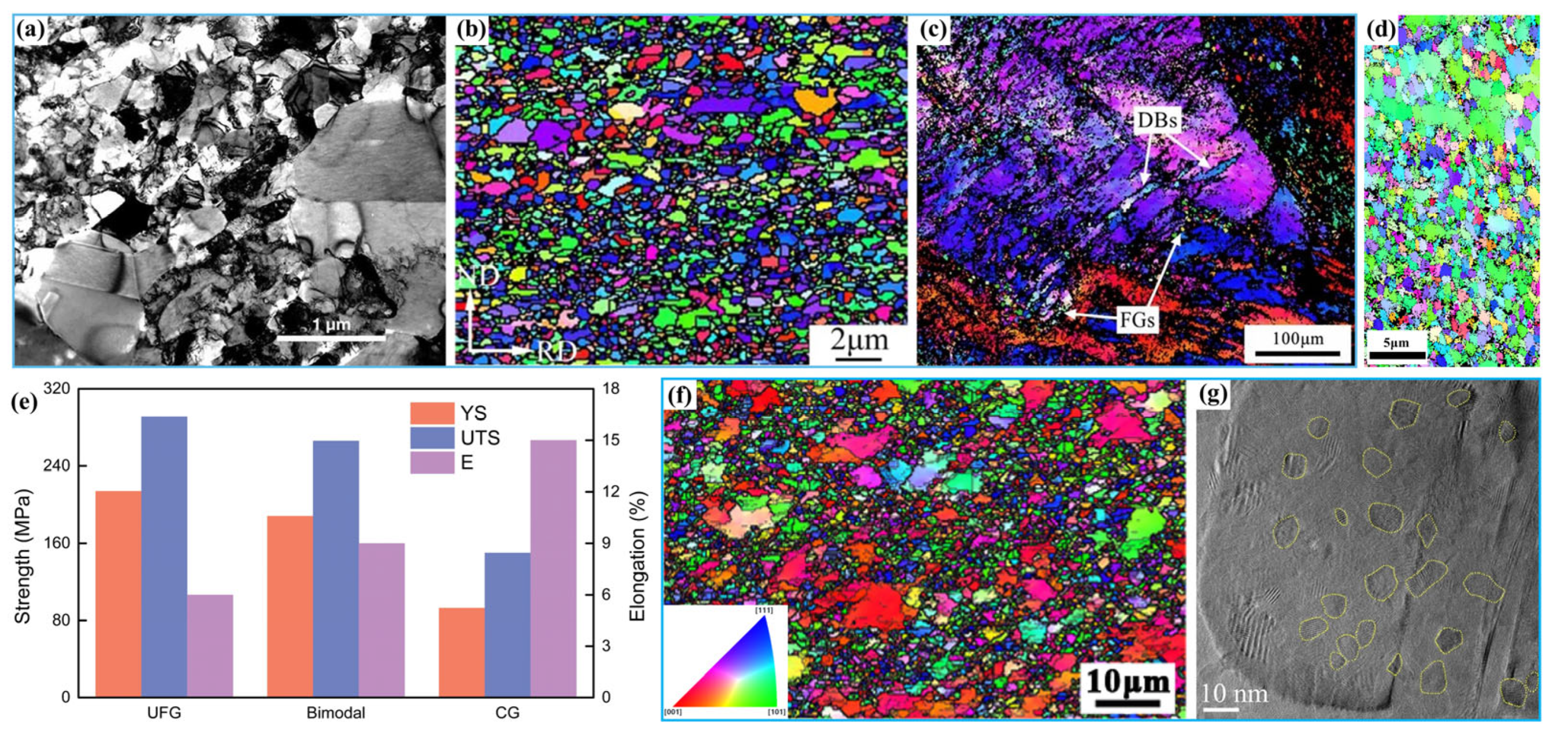
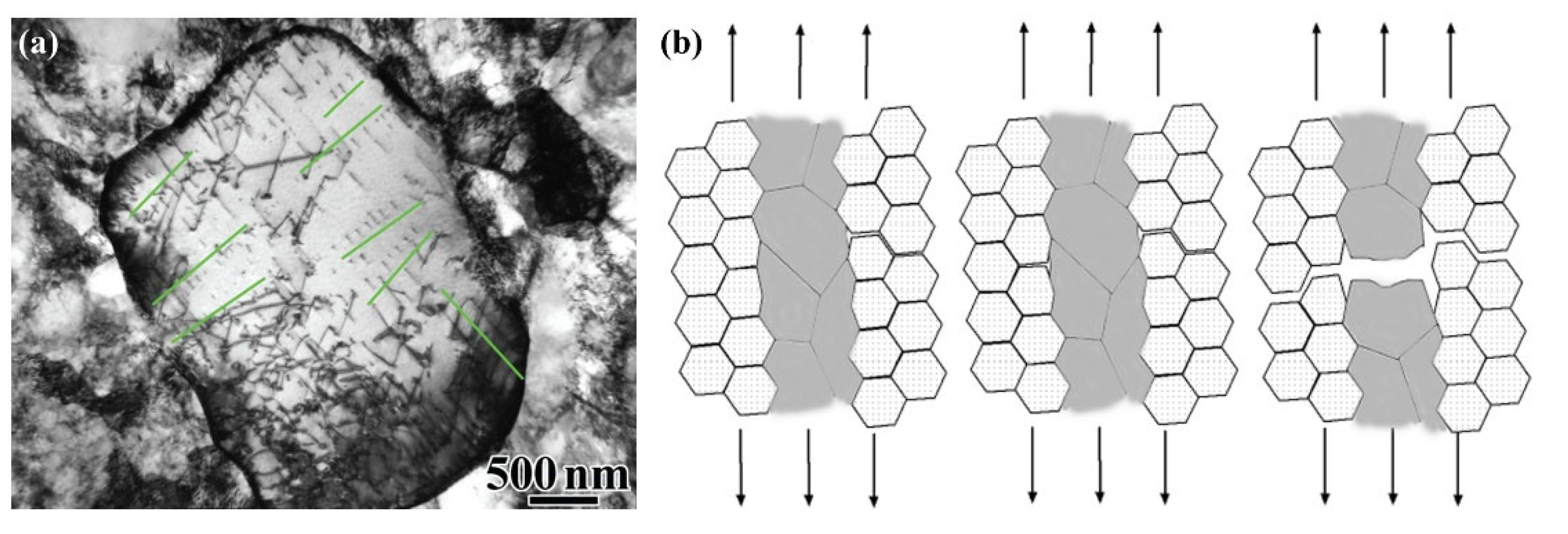
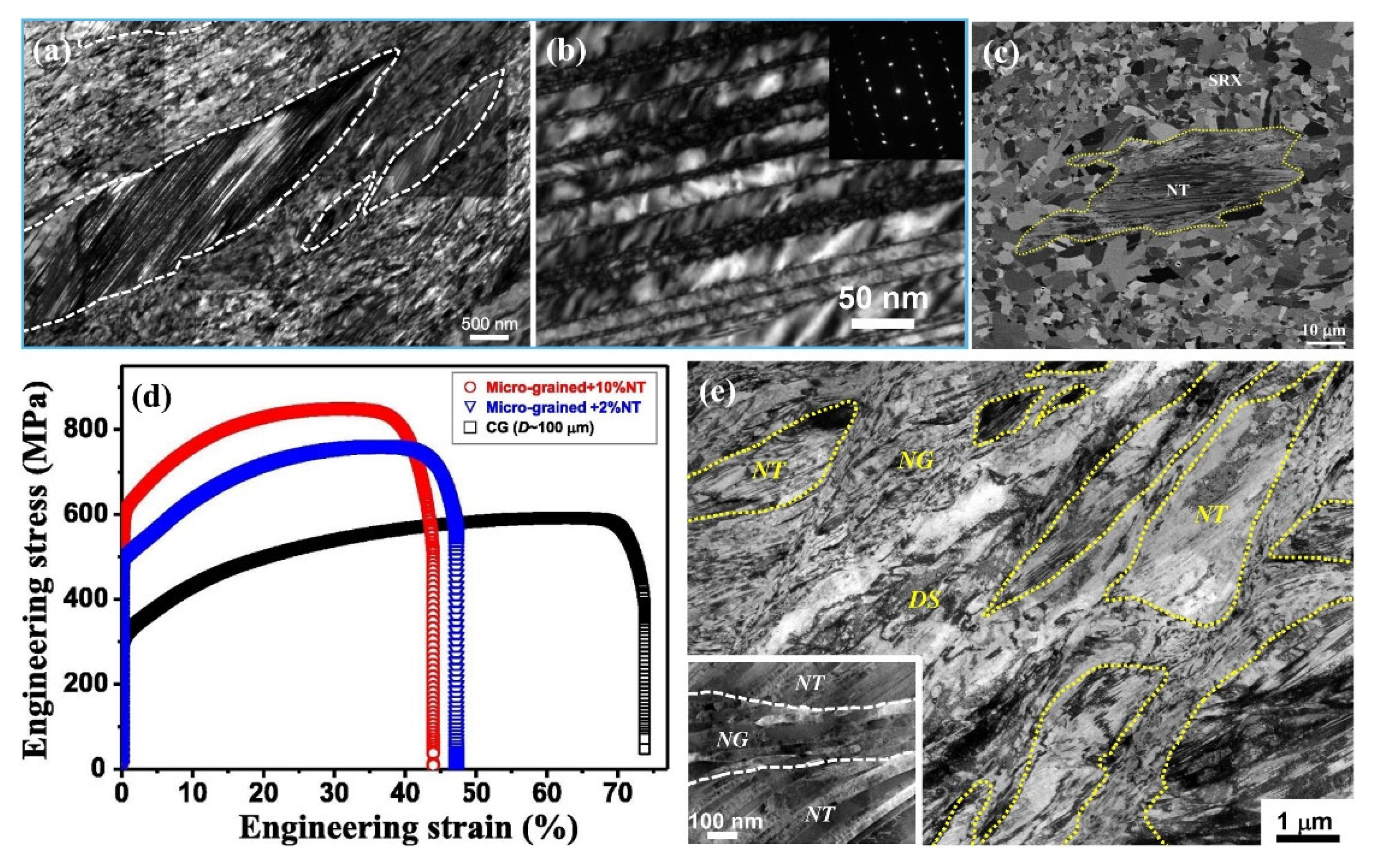

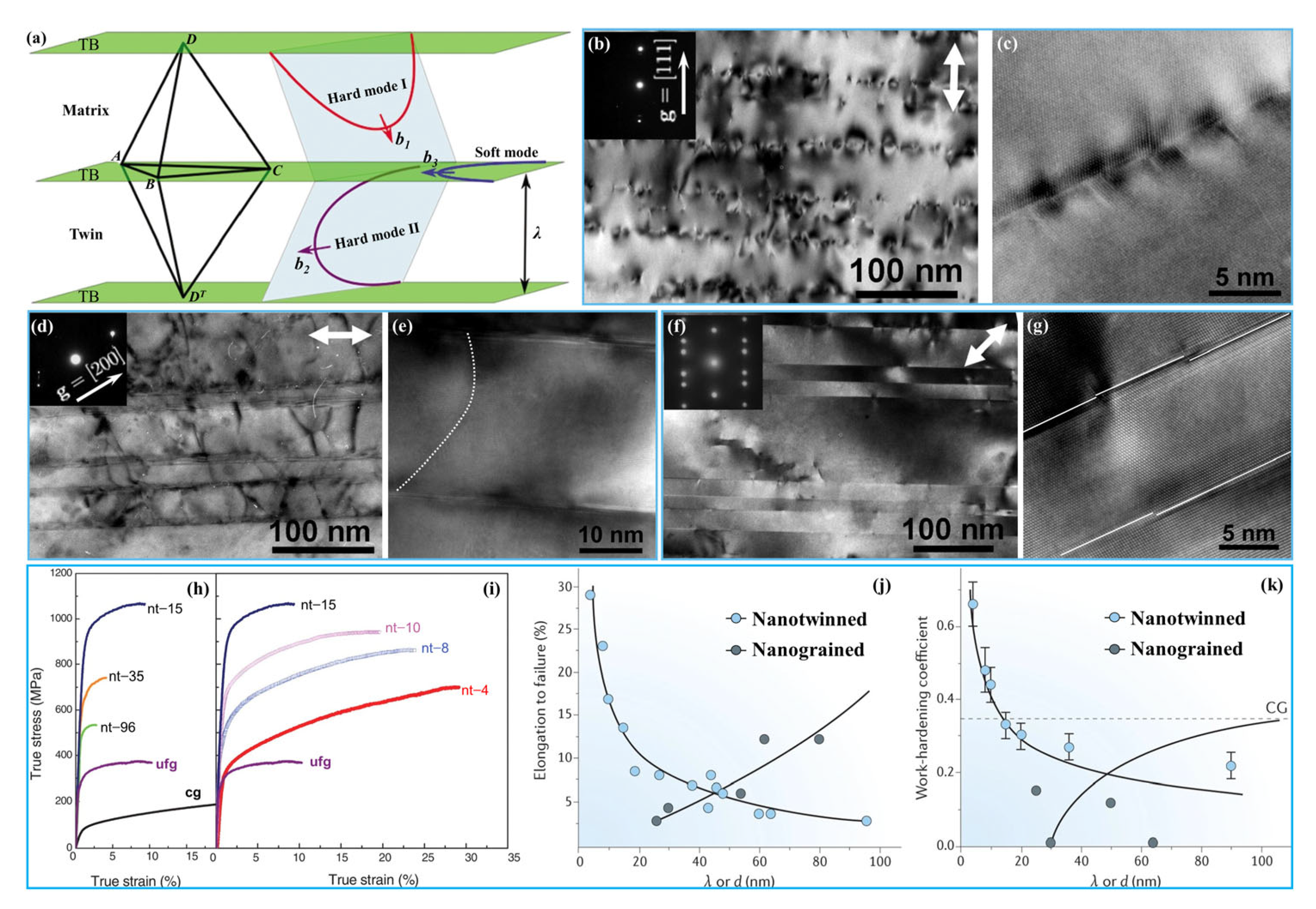
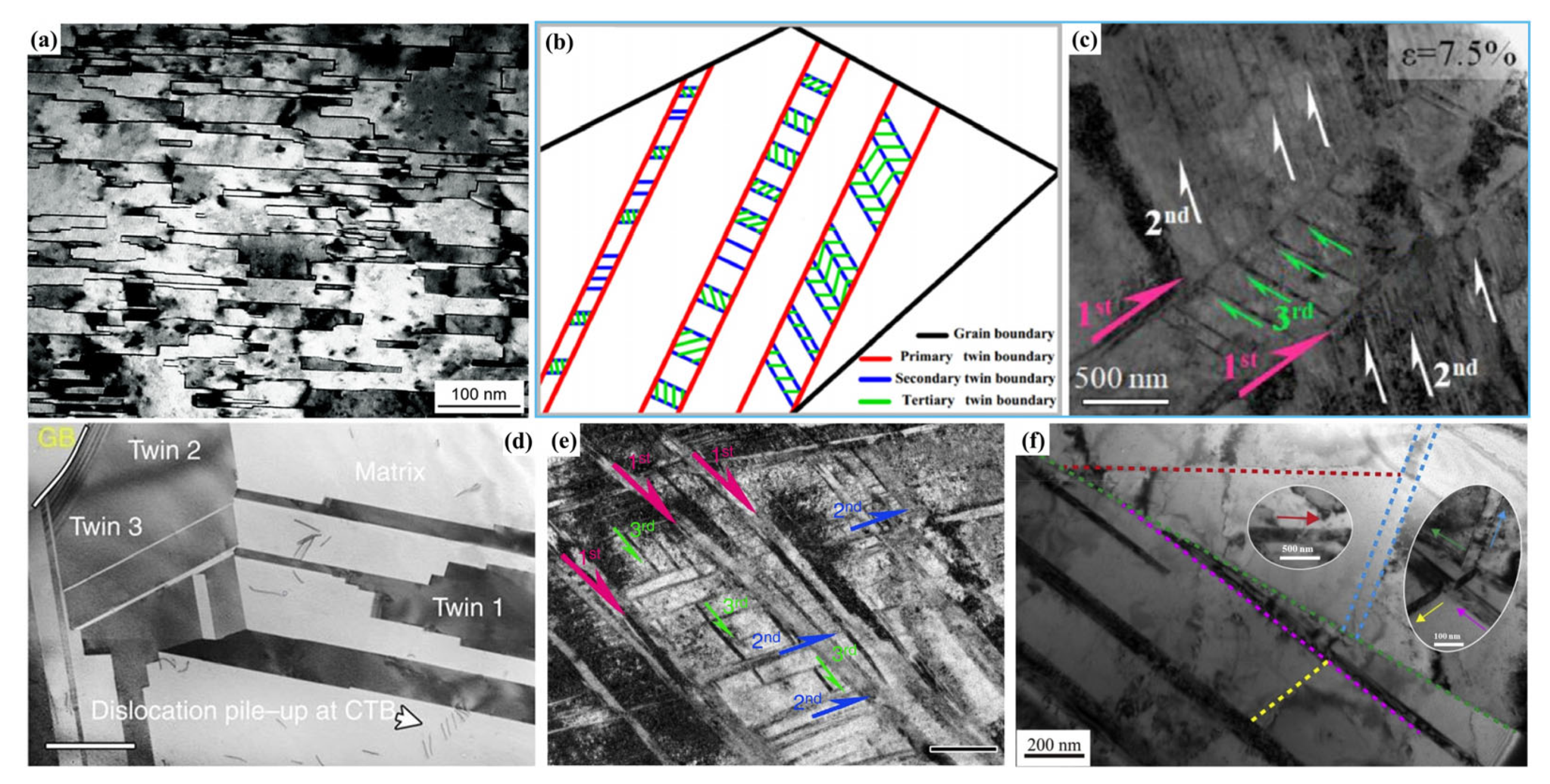
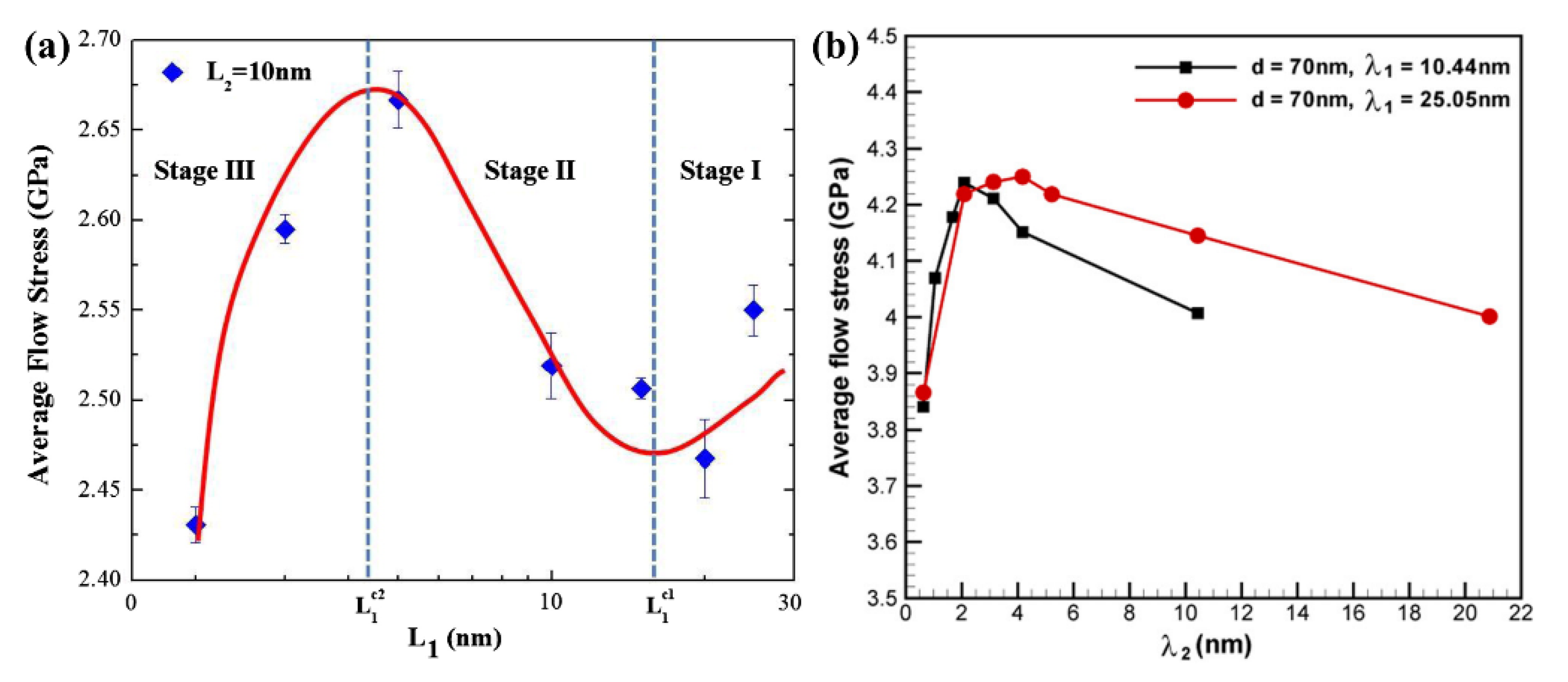
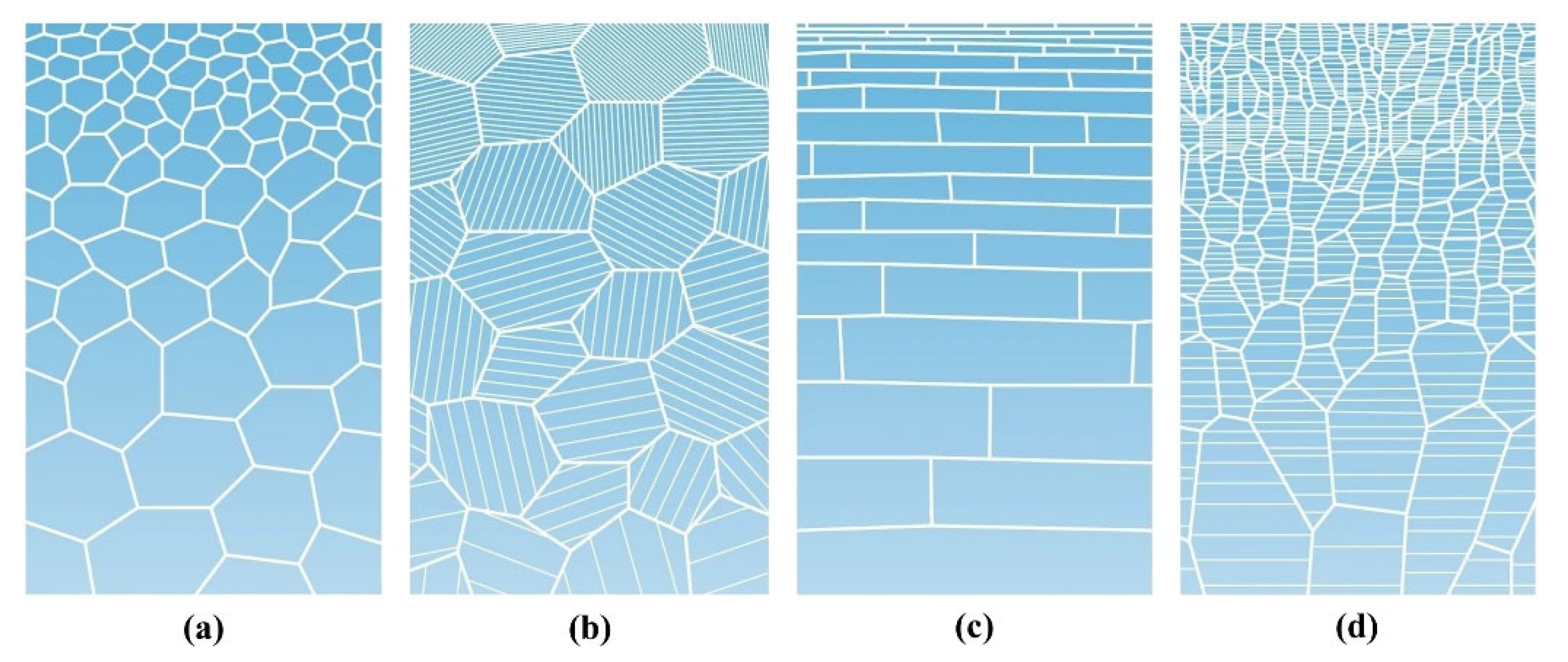


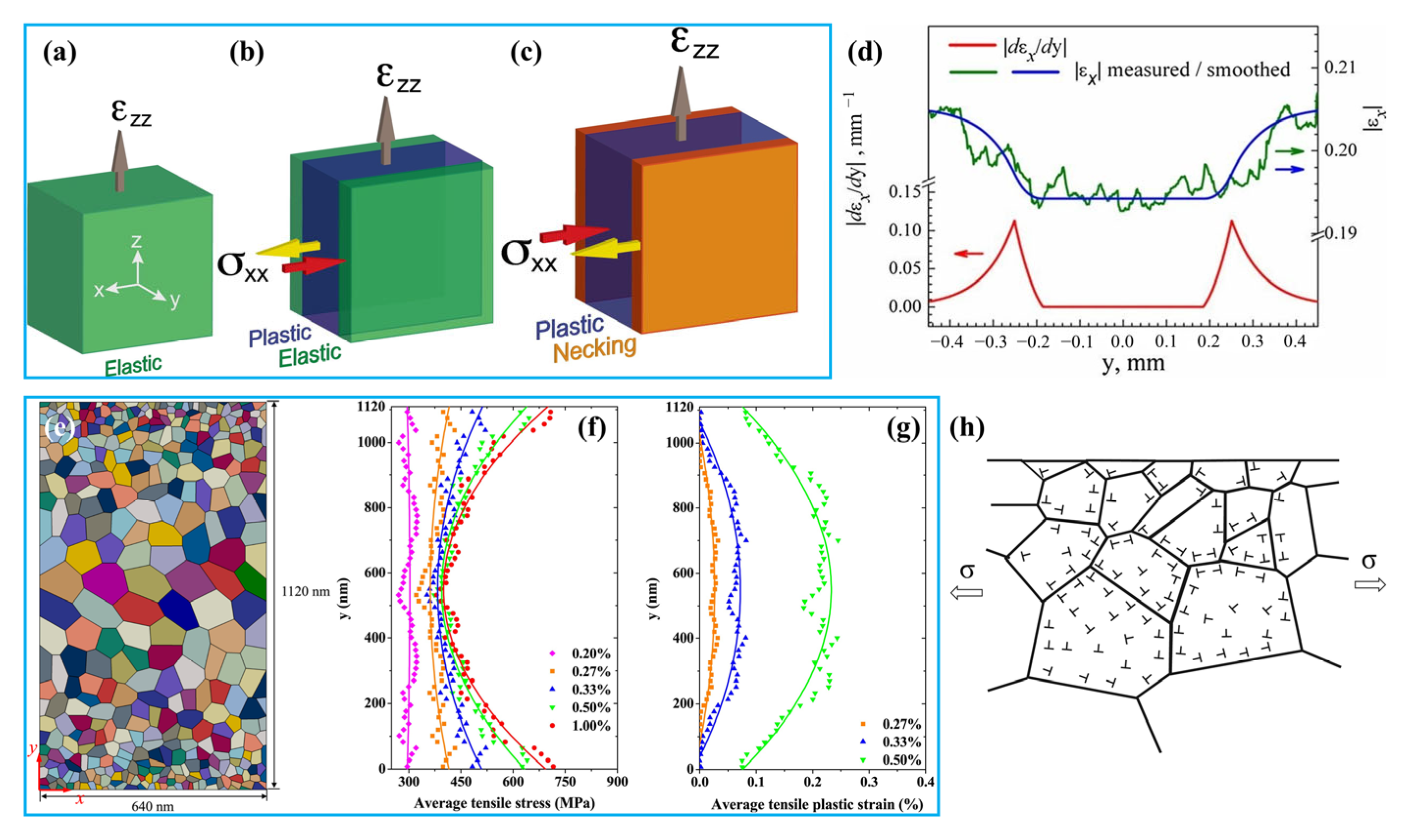

Publisher’s Note: MDPI stays neutral with regard to jurisdictional claims in published maps and institutional affiliations. |
© 2022 by the authors. Licensee MDPI, Basel, Switzerland. This article is an open access article distributed under the terms and conditions of the Creative Commons Attribution (CC BY) license (https://creativecommons.org/licenses/by/4.0/).
Share and Cite
Pu, P.; Chen, T. Nanostructured Metals with an Excellent Synergy of Strength and Ductility: A Review. Materials 2022, 15, 6617. https://doi.org/10.3390/ma15196617
Pu P, Chen T. Nanostructured Metals with an Excellent Synergy of Strength and Ductility: A Review. Materials. 2022; 15(19):6617. https://doi.org/10.3390/ma15196617
Chicago/Turabian StylePu, Pengpeng, and Tijun Chen. 2022. "Nanostructured Metals with an Excellent Synergy of Strength and Ductility: A Review" Materials 15, no. 19: 6617. https://doi.org/10.3390/ma15196617



